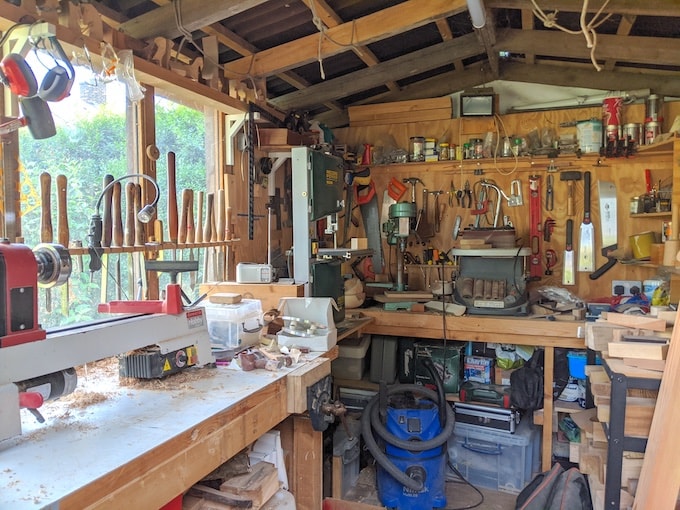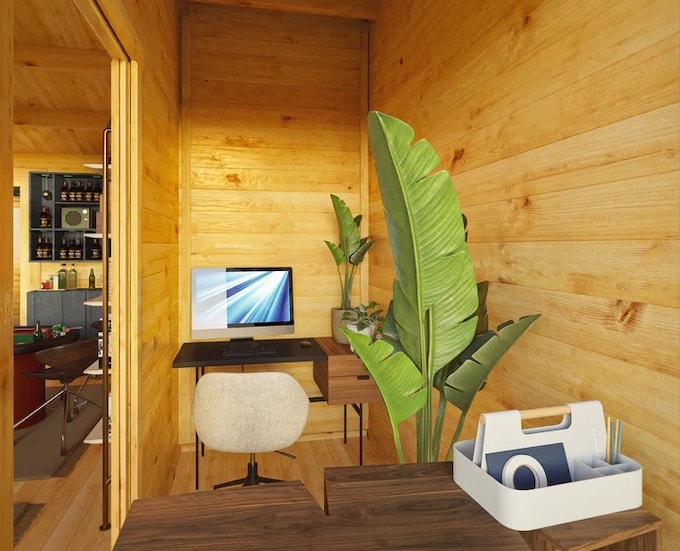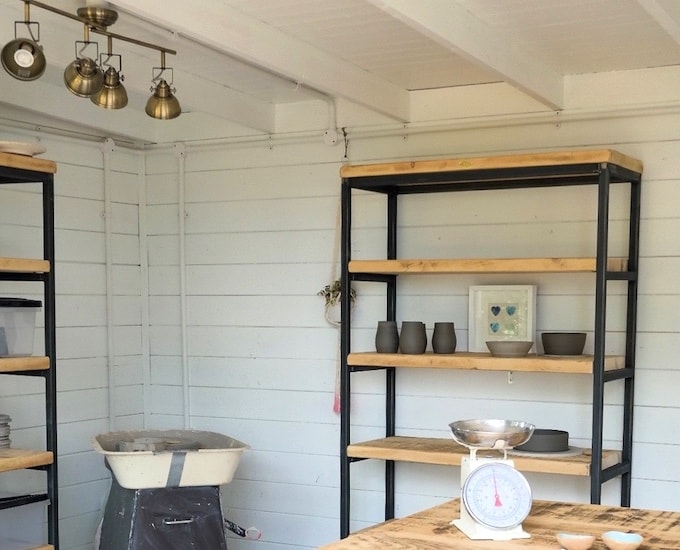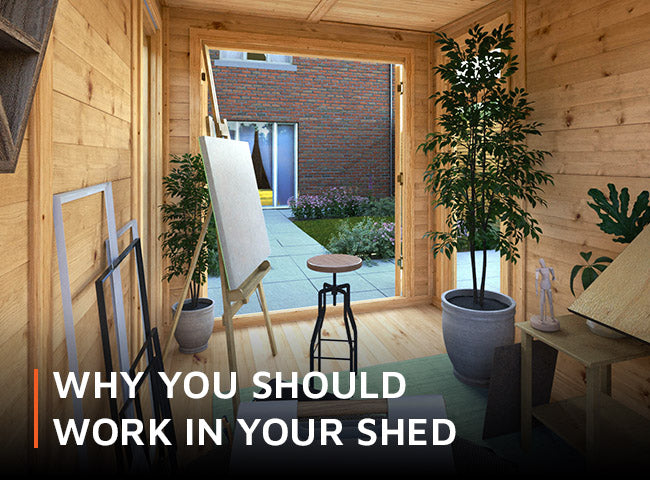More of us than ever are working remotely this year - and that trend looks set to continue. Companies have discovered that remote working works - and it saves on business rent too. But it’s not just employees who are increasingly working from home. It’s something that many self-employed people are already accustomed to.
Whether it’s new to you or not, home working space can become an issue. If you’re working from home, but finding it hard to maintain the boundaries between work and family life, an insulated garden room may be the perfect solution.
We spoke to a range of ‘shedworkers’ who have taken to their gardens to work. They told us why shedworking works for them, whether they’re using their garden buildings as offices or art studios. They also highlight some of the challenges, and ways to overcome them. If this is something you’ve been thinking about, now is the perfect time – and there’s plenty of inspiration here!
Ways to work in your shed

Image: Claire Ackers
There’s a huge variety of work you can do in a garden building. It can be anything from a quiet place to write to a craft room, to a beauty salon! Here are some of the uses to which our shedworkers have put their sheds – and why.
The garden office
Perhaps the most obvious use of your shed as a workplace is an office. Nigel had wanted a garden office for years – and a few months in lockdown finally gave him the time to get organised and do it! The result is a beautiful, cosy space to work, think, reflect and write in.
A step up from using your shed as an office from which to telecommute is running your own business. Claire set up her leadership consultancy in 2015, while on maternity leave. “I lasted 3 days working in the dining room,” she says, “then inspiration struck me – I could build a shed.” Her company ‘shedquarters’ was born.
The art and craft studio shed

Image: @curio.studio
Many of the shedworkers we spoke to run creative businesses – whether painters, potters, woodworkers or crafters. There’s a whole range of craft projects that are better contained in a garden building than your house. And if your crafty side hustle becomes your business, it can double as your office too!
- Painter, Sarah, creates seascapes and landscapes. Her inspiration comes from big skies and the dramatic changing weather of North Yorkshire. When the pandemic lockdown started and her house was suddenly full, she converted her potting shed into the perfect studio: a place to escape, with lots of natural light, and close to the landscape she paints.
- As well as being an architect, Tom at @curio.studio loves making things. He designs, makes and sells wooden toys, games, decorative objects and wood turnings – all of which takes place in his shed. It’s the perfect place to focus on his craft without worry about making a mess.
- Kara Leigh is a potter and pottery teacher. She started working in a 9ft x 6ft shed – but, as her business grew, she needed a larger space in which to produce more work. “I also wanted to be able to teach pottery,” she says, “and for this I'd need a second wheel.” A bigger shed was the perfect solution.
- Bestselling sewing book author Wendy uses her shed as a sewing studio. When she moved from Brighton back home to Sheffield, she grasped the opportunity to build her own workshop – and has never looked back.
- Katie is a designer-maker providing handmade reusable alternatives to help you start your plastic free journey. She launched her business from her house in 2018, but the following year moved it into her shed, “to have my own little space away from the house, that would separate work from relaxation time”.
The beauty salon shed

Image: Microblading Brows by Emily
You don’t have to be crafty to be a shedworker, though. You can even run a public-facing business from your shed.
Emily is a microblading eyebrow artist, who transformed her Waltons log cabin into a gorgeous beauty salon. She needed a space that was clinical and without lots of traffic, so a building in the garden was the perfect solution. She has side access allowing clients to walk straight down to the studio/clinic.
Benefits of shedworking

Image: 5 x 5m Brambling Premium Log Cabin from Waltons
There are some massive benefits to working in a garden shed, and our friendly shedworkers show us that there’s a clear increase in quality of life when you work in your shed.
Reduced costs
Emily says that a big factor in establishing her beauty salon at the bottom of the garden was avoiding the costs of rent and rates. “It was far cheaper than renting a space, especially as a new business.” Kara Leigh agrees: “It means I don't have to pay rent on a studio. It really is the perfect solution for me.”
Avoiding these costs makes running your own business far less stressful. Wendy dreamed of working in a shed for a long time, and found that not having those expense made: “...a massive difference to my mental health.”
Short commute to the garden shed
Claire says the best thing about shedworking is the commute: “It’s 15 steps from my back door to work!” Emily loves being close to home, but also enjoys the separation: “Although it’s at home, I feel like I leave for work”, And for Wendy, “It’s at the bottom of my garden which I love. I’m separate from the house, but nearby.”
A separate space for work in the garden

Image: The Corner Arts Studio
The detachment, and its importance for work-life balance is key. Kara Leigh says: “I'm able to work from home but keep it separate from family life”. Sarah appreciates the focus that having a separate space offers: “Being out of the house, I’m also not tempted to do little domestic jobs and get waylaid.”
The decision to work in a separate garden room often comes from having previously tried working in the house. Wendy finds it a big step up from working in the spare room, and Katie found that the dining table was fine at first, “...but it made a mess of the kitchen and I couldn’t walk away from it, giving me no work-life balance.”
Freedom to make a mess
Many shedworkers run quite messy businesses! For them, working from a shed is essential to keeping the house not just tidy but undamaged. Pottery in particular would be completely impractical in a house. Kara Leigh acknowledges that pottery is messy work, “...plus the kiln produces fumes so to have it in our tiny cottage was never an option.”
Sarah loves having her own, dedicated workspace in the garden: “My shed is very much a working space. It’s messy – but I love it. I’m free to concentrate on my artwork entirely.” Tom was keen to have a space where he could leave tools and work-in-progress lying around. There’s only so long the dining table is good for this.
Work closer to nature

Image: Cotton Lily
Several of our shedworkers spoke of the benefits of being close to nature. Nigel says the best thing is “the peace and quiet, the light and the lovely sounds of the birds drifting in from the garden.” He lives in the Lake District, where summers are brief – so he wants to make the most of them.
Katie agrees: “For me the best thing is being closer to nature in my own garden. I find it relaxes me, helps my business flourish with ease and the creativity just keeps coming. It’s the perfect place to work.” Wendy tells us: “It means I can work close to nature and have a bird feeder right outside my window which is busy a lot of the day.”
Shedworking challenges

Image: Kara Leigh Ceramics
Shedworking may open up a brave new world of shed-based opportunities – but it’s not without its challenges. Here are some of the challenges our shedworkers faced – and how to overcome them.
Seasonal variations
There’s no getting away from it: your outbuilding is, by definition, outside. This can bring seasonal challenges – but there are solutions.
Emily says her biggest challenge was painting the interior, as “the wood swells with heat.” For Katie, it’s cold, dark winters. Claire struggles most with fluctuating temperatures: “Freezing printer ink in the winter, and it’s like a sauna in high summer (I’ve been known to work in my bikini!)”
There are many ways to heat and ventilate your garden building to keep an even, comfortable working environment. And ventilation will help with summer humidity too. Katie solved her year-round-use problem by insulating her shed and adding electricity, so she had light and heating during her busier winter months.
Limited space
Nigel says his greatest challenge was getting the space right – especially when it’s at a premium. His advice is to “keep it minimalist. Don’t try to replicate the home office!” Minimalism will help you maintain a calm and ordered working space, even in a small shed.
Sometimes you reach a point when your business – or your creative output – grows. You’re going to need a bigger shed! However, if budget or space don’t allow for an upgrade, it may be possible to spill over into the house while still maintaining a separate, focused shedworking space.
Sarah says: “I still need to carry some works into the house for storage and drying space, but other than that there are only positives to working in a shed.”
Becoming a shedworkaholic!

Image: The Hemlock 5m x 3m Left Sided Corner Log Cabin
The flip side of using a shed to keep work and home life separate is that, sometimes, it can be hard to leave your shed and go back to the house!
Kara Leigh confirms this: “It's very easy to pop out to the studio on a weekend and lose three hours!” This may be less of a problem for a passion project; but if you’re finding it hard to leave your office job, try to set some boundaries – and leave work on time!
Whatever your reasons for shedworking, the benefits of your own separate space are huge. Whether you want a quiet place for uninterrupted Zoom meetings, a hub to build your business empire, or even somewhere to work on messy art projects, a garden building is the perfect retreat. As working from home becomes more prevalent, this will only become more important.
If you’re thinking about taking the shedworking plunge, have a look at our other shedworking posts - once you embrace #shedlife there’s no going back!




